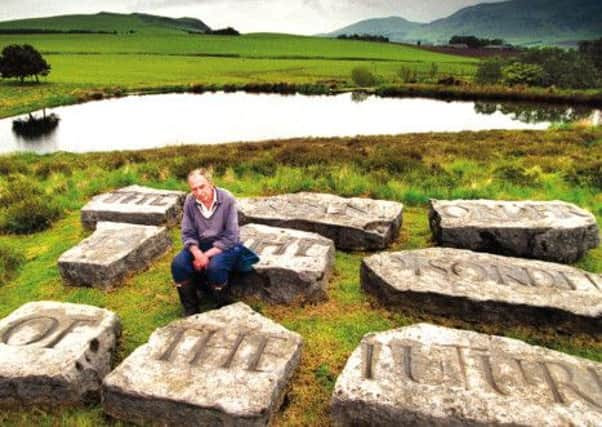Little Sparta to be study centre for art scholars


The former home of acclaimed artist Ian Hamilton Finlay in Lanarkshire is to become a study centre for art scholars after signing a deal with Edinburgh University.
The garden represents the life’s work of Hamilton Finlay, with nearly 300 of his whimsical artworks and “concrete poetry” across five acres of ponds, streams, meadows and groves in the Pentland Hills.
Advertisement
Hide AdAlthough it boasts a world-wide following, it has often struggled to appeal to a wider Scottish public. Fewer than three thousand people make the journey to his garden a year and its fragile mix of sculptures and planted paths cost close to £100,000 a year to maintain.
Courses at the garden will begin next year in the house where Hamilton Finlay, who died in 2006, lived for more than 30 years while amassing his collection.
Magnus Linklater, the chairman of the Little Sparta Trust and former Scottish Arts Council chairman, said the connection to Scotland’s leading university would underline the garden’s national and international profile and bring a vital source of new revenue.
“I’m keen that this will give Little Sparta the financial support on which we depend,” Linklater said. “We live quite a hand-to-mouth existence. We get no public funding at all, from any government agency, relying entirely on fund-raising, visitors’ entrance fees, and our friends and patrons.
“It’s a tough thing to keep this garden going, and in the manner and style which Ian Hamilton Finlay himself insisted on. It is a very fragile garden and you just can’t throw its gates open to thousands of visitors because it would be ruined. Nevertheless, it needs to be maintained, nurtured and supported, and I’ve always felt it needs ideally to form a partnership with some larger organisation.”
Edinburgh University’s new relationship with Little Sparta will launch in September with a two-day international academic conference partly hosted at the site. Edinburgh College of Art is now part of the university after a merger two years ago.
Advertisement
Hide Ad“Those of us in the university who know the site, know the extreme importance to the artistic landscape of Scotland,” said Frank Gribben, the university’s registrar of its college of humanities and social sciences. “It’s incredibly unvisited, and there’s not nearly enough people benefiting from an awareness and appreciation of it. There’s an obvious point of shared interest, in bringing students on to the site.”
The study centre would generate vital income for Little Sparta from tuition fees, but also bring the chance of grants from arts or academic foundations.
Advertisement
Hide AdHamilton Finlay started work on the farm at Stonypath, in the Pentlands, in 1966, with his wife Sue, and continued it until his death. He was a pioneer of “concrete poetry”, typically simple poems where the layout and form of words are as important as the text itself. He named it Little Sparta as a joke after Edinburgh started being referred to as the “Athens of the North”.
His writing and sculpture ranged from classical Greek styles to French revolutionary philosophy and the battles of the Second World War, all reflected in the works at Little Sparta. His work is hard to categorise, even his admirers admit.
Built up over several decades, Little Sparta’s attraction range from wry verbal jokes – like the inscription “Bring Back the Birch”, amid a cluster of birch trees – to a birdbath in the shape of a battleship.
Hamilton Finlay’s international profile has continued to rise since his death, with a major exhibition in the Tate Modern that ended earlier this year. He was the only British artist whose work was exhibited at the Sao Paulo Biennale in Brazil in 2012. But Little Sparta’s annual income is low even though the garden was ranked Scotland’s greatest artwork in a Scotland on Sunday poll of art critics and it was runner-up – to a Gainsborough work – in a list of “must-see” art attractions in a national newspaper earlier this month.
But unlike Jupiter Artland, the newer and more high-profile sculpture park on the outskirts of Edinburgh, Little Sparta, in an exposed Pentlands farm well off the beaten tourist track, is entirely Hamilton Finlay’s work, with no roster of other famous artists.
Visitors pay £10 to visit the garden, open only on three afternoons a week through the summer. While some trustees are said to think it could host as many as 10,000 people a year, Linklater said a maximum sustainable figure was 4,000 to 5,000, with its narrow paths and intimate groves. The small numbers have ruled it out for many grant-funding bodies which demand bigger audiences.